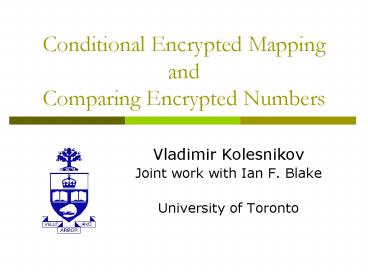Conditional Encrypted Mapping and Comparing Encrypted Numbers - PowerPoint PPT Presentation
Title:
Conditional Encrypted Mapping and Comparing Encrypted Numbers
Description:
I am selling a ticket to Anguilla. $1000. One hundred million dollars! ... I have no idea what the bids were. What if bidders lie about the result? ... – PowerPoint PPT presentation
Number of Views:65
Avg rating:3.0/5.0
Title: Conditional Encrypted Mapping and Comparing Encrypted Numbers
1
Conditional Encrypted Mapping andComparing
Encrypted Numbers
- Vladimir Kolesnikov
- Joint work with Ian F. Blake
- University of Toronto
2
Privacy in Auctions
Note to self spam Austin with 999 tickets offers
I am selling a ticket to Anguilla.
1000
One hundred million dollars!
Sorry
Deal!
3
Comparing Encrypted Numbers
I have no idea what the bids were
Enc(100000000)
Enc(1000)
Enc(0)
Enc(1)
I lost
I won
What if bidders lie about the result?
4
Conditional Encrypted Mapping (CEM)
Prepare two secrets s1 signed contract s0
loser notification
Enc(100000000)
Enc(1000)
Enc(s0)
Enc(s1)
s0
s1
5
Q-CEM
s0, s1
Q(x,y)
mRmap(s0, s1, e0, e1, pk)
e0 Enc(x)
e1 Enc(y)
m
?
?
Rec(m, sk) sQ(x,y)
Pair (Rmap, Rec) for Q is a Q-CEM
6
Definitional Choices
CEM Rmap(s0, s1, e0, e1, pk), Rec(m, sk)
- Strong notion of privacy
- Output of Rmap contains no statistical
information other than the value sQ(x,y) - Strong composability
- Holds for all generated key pairs, valid inputs
and randomness used in encryption - E.g. Adv does not benefit from maliciously
- choosing randomness when encrypting inputs
7
Definitional Choices
CEM Rmap(s0, s1, e0, e1, pk), Rec(m, sk)
- Do not specify security requirements of the
- encryption scheme
- One definition is useable in most settings
- Delay discussion of easy but tedious details
(e.g. what if inputs contain decryption keys) - Q-CEM with semantically secure encryption gives
a protocol in the semi-honest model - can be modified to withstand malicious players
(ZK or the light-weight CDS)
8
Some of Related Work
- Auctions and GT
- Naor, Pinkas, Sumner 1999
- Di Crescenzo 2000
- Fischlin 2001
- Laur, Lipmaa 2005
- Many others
- CEM
- Conditional Oblivious Transfer and variants
- Di Crescenzo, Ostrovsky, Rajagopalan 1999
- Gertner, Ishai, Kushilevitz, Malkin 1998
- Aiello, Ishai, Reingold 2001
- Di Crescenzo 2000
- Laur Lipmaa 2005
9
Tools Homomorphic Encryption
- Encryption scheme, such that
- Given E(m1), E(m2) and public key,
- allows to compute E(m1 m2)
We will need
- Additively homomorphic ( ) schemes
- Large plaintext group
The Paillier scheme satisfies our requirements
Can compute E(cm1 m2) from c, E(m1), E(m2)
10
The GT-CEM Construction
s0, s1
x
y
x1, , xn
d
Linear Map
0 ? R -1 ? s01 ? s1
0 ? R -1 ? ES01 ? ES1
- ESi is a randomized encoding of si
- contains no other information
11
Randomized Mapping
Given s0, s1
f(-1) b-a ES0 (1) f(1) ab ES1
(2) f(0) b ½ (ES0 ES1)
ES0, ES1, f(x) ax b
Assume s0, s1 contain redundancy
Choose R 2R ZN. View R as blocks r0, r1 R r0
2k r1
r0
r0
r1
s0
s0
_ _ _ _ _ _. _ _ _ _ _
_ _ _ _ _ _. _ _ _ _ _
ES0 ES1
s1
r1
r1
r0
s1
_ _ _ _ _ _. _ _ _ _ _
_ _ _ _ _ _. _ _ _ _ _
c0
c1
c 2R 0,1
- Set f axb to satisfy (1),(2)
- f(-1), f(1) contain s0, s1 and no extra
information - f(0) ½ (ES0 ES1) ½ (s0 2k r1 r0 2k
s1) - ½ (R ) R
12
Resource Comparison
Orders of magnitude improvement over GM-based
schemes Performance similar to previous
Paillier-based COT schemes
- c-bit secrets are transferred based on comparison
of n-bit numbers. - and ? are the correctness and security parameter
13
Conclusions
- General and convenient definition of CEM
- CEM for any NC1 predicate
- GT-CEM Constructions
- Simple and composable
- Especially efficient for transferring larger
secrets ( e.g. ¼500-1000 bits ) - Applications to auctions, etc































